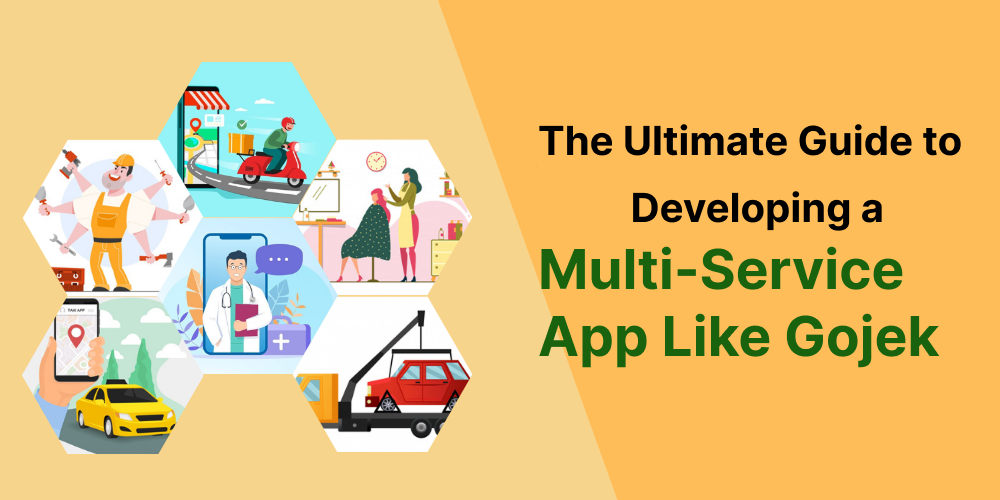In today’s digital-first world, convenience drives consumer behavior. The rise of multi-service platforms like Gojek has revolutionized the way people access everyday services—from booking a ride and ordering food to getting a massage or scheduling home cleaning. These apps simplify life by merging multiple services into a single mobile solution.
If you’re an entrepreneur or business owner looking to develop a super app like Gojek, this guide will walk you through everything you need to know—from ideation and planning to features, technology, cost, and launching.
1. Understanding the Gojek Model
What is Gojek?
Gojek is an Indonesian-based multi-service app that started as a ride-hailing service and evolved into a digital giant offering over 20 on-demand services. It now serves millions of users across Southeast Asia, making it one of the most successful super apps in the world.
Why Is the Gojek Model Successful?
- Diverse Services: Gojek bundles transport, delivery, logistics, and home services in one app.
- User Convenience: One login for multiple services.
- Loyalty Programs: Rewards and incentives for repeat users.
- Scalability: Built to adapt and scale rapidly.
2. Market Research and Business Planning
Before writing a single line of code, you must understand the market and define your niche.
Key Steps:
- Competitor Analysis: Study apps like Gojek, Grab, Careem, and Uber.
- User Persona Development: Identify your target audience and their pain points.
- Service Selection: Decide which services to offer at launch—e.g., taxi rides, food delivery, parcel delivery, or healthcare.
- Monetization Model: Plan your revenue streams (commission-based, subscription, ads, etc.).
3. Essential Features of a Multi-Service App
A. User App Features
- User Registration & Login
- Multi-Service Dashboard
- Real-Time Tracking
- Secure Payments
- Reviews & Ratings
- Push Notifications
- Loyalty & Referral Programs
B. Service Provider App Features
- Service Registration
- Availability Toggle
- Request Management
- Earnings Dashboard
- Ratings & Feedback
C. Admin Panel Features
- User & Provider Management
- Commission Tracking
- Service Management
- Reports & Analytics
- Promotions & Discounts Management
4. Choosing the Right Tech Stack
The technology behind your app will determine its performance, scalability, and user experience.
Backend
- Programming Languages: Node.js, Python, or Java
- Databases: MongoDB, MySQL, Firebase
- Hosting: AWS, Google Cloud, Microsoft Azure
- APIs: REST or GraphQL
Frontend
- Mobile Platforms: Android (Kotlin/Java), iOS (Swift)
- Cross-Platform: Flutter or React Native
- Web Dashboard: Angular, React.js, or Vue.js
Other Technologies
- Payment Gateways: Stripe, Razorpay, PayPal
- Geolocation: Google Maps API
- Push Notifications: Firebase Cloud Messaging (FCM)
- Chat Functionality: Socket.IO or Firebase
5. Design and User Experience (UX)
Design is crucial in a super app where users interact with multiple services.
UX/UI Design Tips:
- Intuitive Interface: Simplify navigation between services.
- Consistent Aesthetics: Maintain color schemes and branding across all screens.
- Microinteractions: Small animations or responses that enhance user satisfaction.
- Accessibility: Consider voice commands and larger fonts for inclusivity.
6. Development Phases
A well-planned development cycle ensures timely delivery and quality output.
A. Discovery Phase
- Finalize scope
- Create wireframes and user flows
- Define technology stack
B. MVP Development
Start with a Minimum Viable Product including essential features to test market response.
C. Full-Scale Development
Once the MVP is validated, build advanced features and integrations.
D. Testing
Conduct extensive testing:
- Unit Testing
- Integration Testing
- User Acceptance Testing (UAT)
- Performance Testing
7. Launching the App
Pre-Launch Checklist
- App Store Optimization (ASO)
- Marketing campaigns
- Beta testing and feedback
- Final round of bug fixes
Post-Launch
- Monitor performance
- User support
- Continuous updates
- Roll out new features based on feedback
8. Marketing Your Multi-Service App
Marketing is key to onboarding users and service providers.
Strategies:
- Pre-Launch Hype: Use teasers, landing pages, and early access invites.
- Influencer Collaborations: Partner with local influencers.
- Referral Programs: Encourage user growth via rewards.
- Local SEO: Optimize for city-based searches.
- In-App Promotions: Offer discounts and bundle deals.
9. Legal and Compliance Considerations
Don’t overlook legal matters when launching a multi-service platform.
Key Aspects:
- Licensing: Depending on your country and the services offered.
- Data Protection: Adhere to GDPR, HIPAA, or local data laws.
- Contracts: Create terms of service for providers and users.
- Taxation: Prepare for tax compliance across services.
10. Monetization Strategies
There are several ways to make money from your app.
Common Revenue Models:
- Commission Per Transaction: Standard in ride-sharing and food delivery.
- Subscription Plans: For users or service providers.
- Ads: In-app promotions and sponsored listings.
- Surge Pricing: Dynamic pricing based on demand.
- Premium Features: Offer enhanced services at a cost.
11. Challenges and How to Overcome Them
A. Managing Multiple Services
Solution: Use microservices architecture to manage each feature/module independently.
B. Balancing Supply and Demand
Solution: Use AI to predict demand and onboard providers in advance.
C. User Retention
Solution: Gamify the app with loyalty points, badges, and regular updates.
D. Operational Costs
Solution: Optimize cloud resources, automate processes, and start with limited geography.
12. Scaling the App
Once you establish your base, consider expansion.
Tips:
- Add New Services: Include healthcare, legal help, or finance.
- Geographical Expansion: Move into new cities or countries.
- Language Support: Add multi-lingual capabilities.
- API Integrations: Partner with external platforms for payment, maps, or logistics.
13. Cost of Developing a Multi-Service App Like Gojek
Costs can vary based on complexity, features, region, and team size.
Estimated Breakdown:
- MVP Development: $20,000 – $40,000
- Full-Feature App: $50,000 – $150,000+
- Monthly Maintenance: $2,000 – $10,000
- Marketing Budget: $5,000 – $50,000 (initial phase)
Hiring an experienced team or opting for a white-label solution can help manage costs and time.
Conclusion
Building a multi-service app like Gojek is an ambitious but achievable project. With the right strategy, a well-defined feature set, and an expert development team, you can tap into the ever-growing on-demand economy. Begin by understanding your users, develop a scalable platform, market effectively, and continuously improve based on feedback. The super app revolution is just beginning—get ready to be a part of it.
Frequently Asked Questions (FAQs)
1. How long does it take to develop a Gojek-like app?
Depending on complexity and team size, it typically takes 4 to 8 months to build a fully functional version of a multi-service app.
2. Can I start with only a few services and expand later?
Absolutely. It’s recommended to begin with 2–3 core services, test the market, and expand based on user demand and operational capability.
3. Is it better to build from scratch or use a white-label solution?
If you want custom features and long-term scalability, building from scratch is ideal. White-label solutions are faster and more affordable for quicker market entry.
4. How do I onboard service providers to my platform?
Create a simple registration process, offer initial incentives, and run targeted local campaigns to onboard and retain quality service providers.
5. What is the best monetization model for a super app?
The most successful models include commission-based earnings, subscription plans, and in-app advertising, depending on your services and user base.




